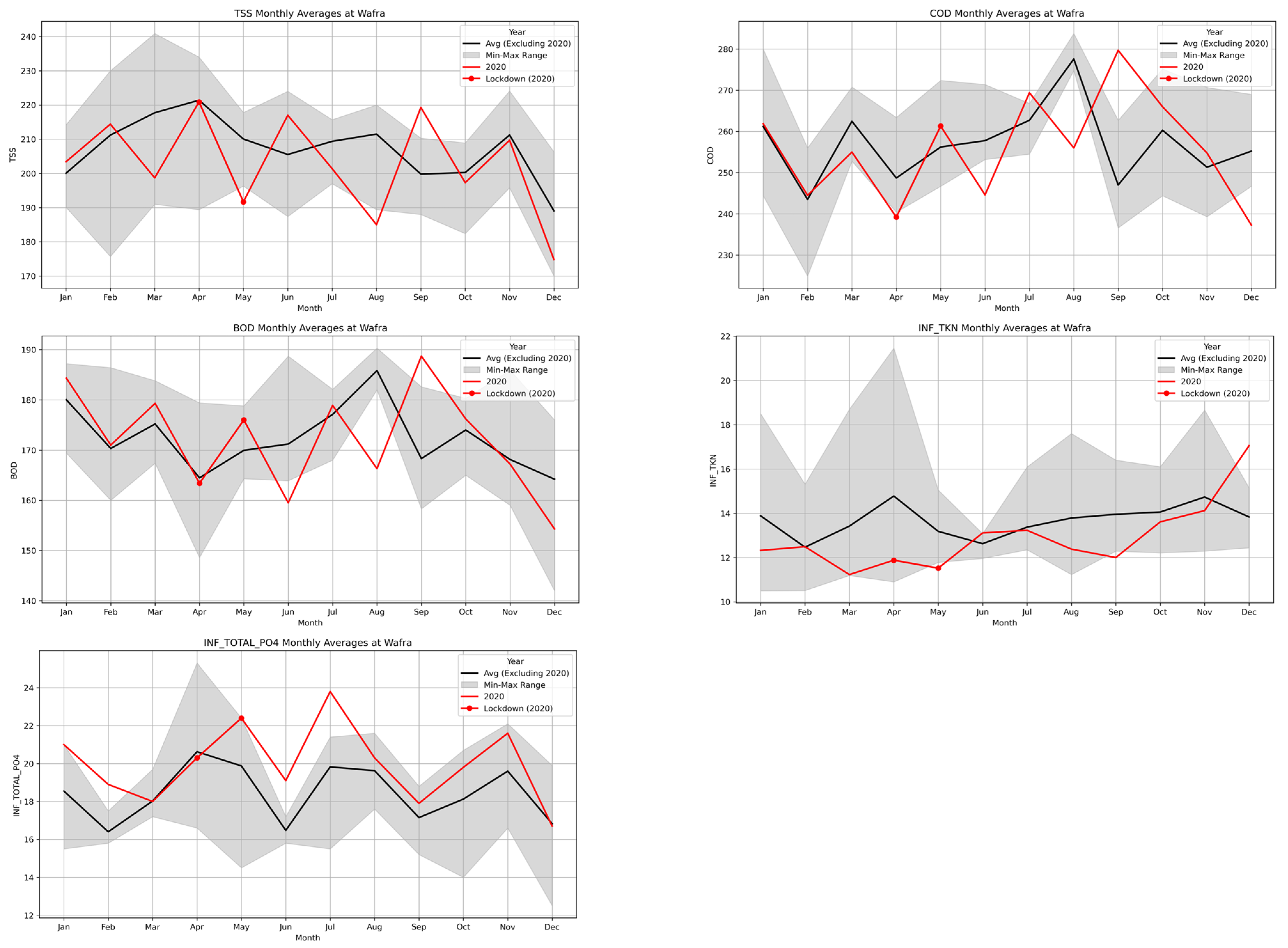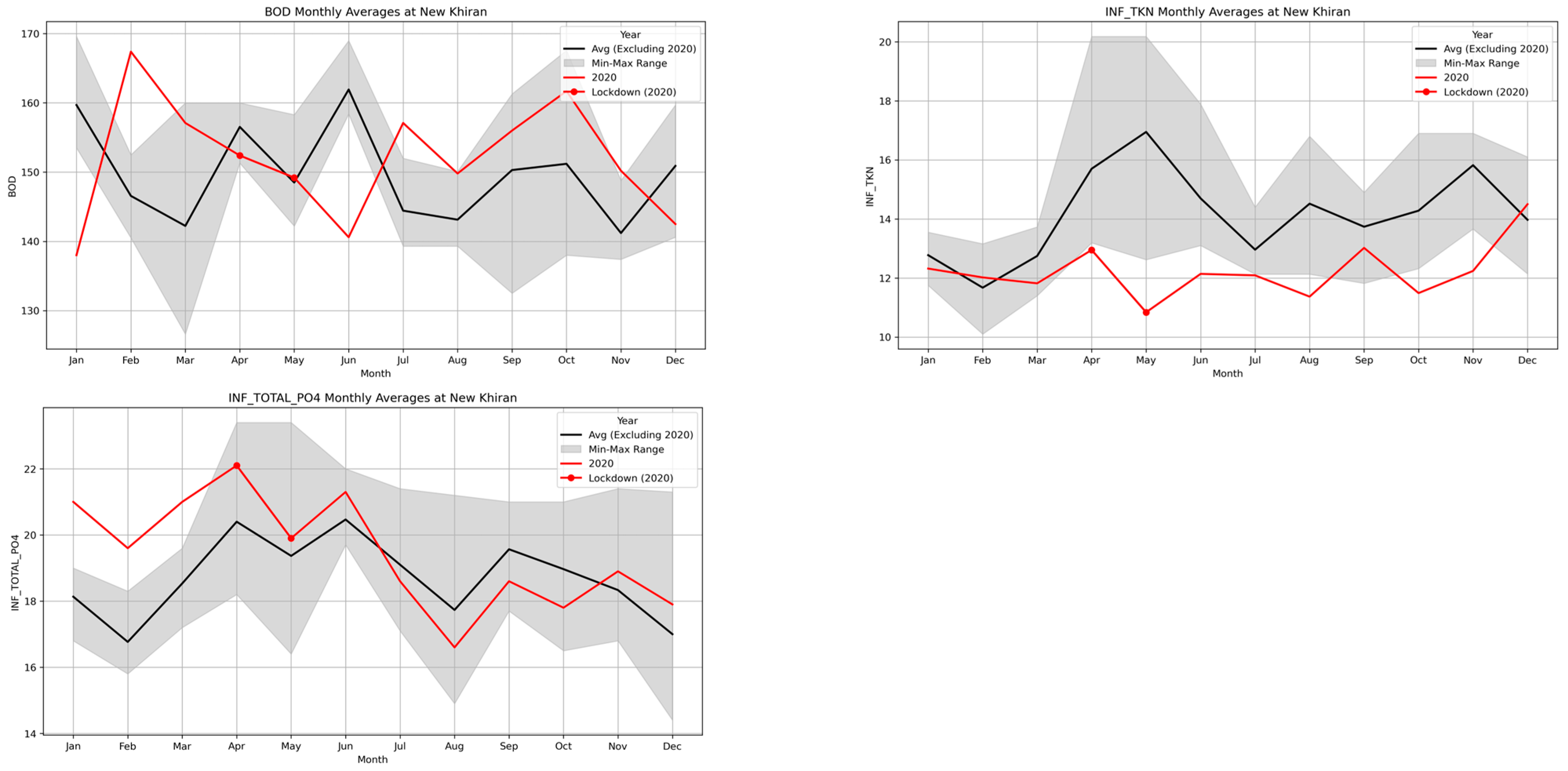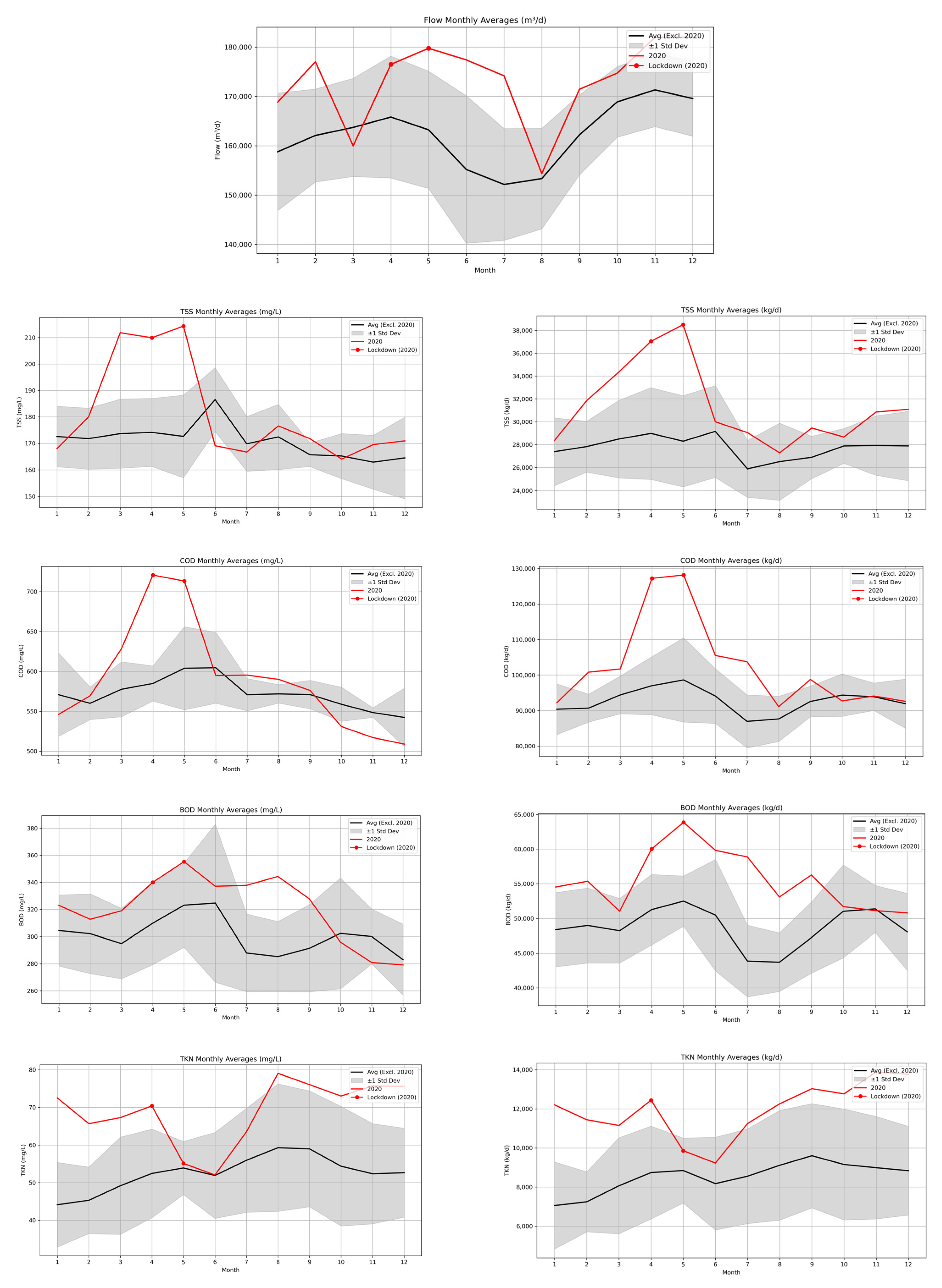COVID-19 and Wastewater Management in Semi-Arid Regions: Observations and Global Comparisons from a GCC Country
Abstract
1. Introduction
2. Material and Methods
2.1. Selection of Study Area
2.2. Study Design and Setting
2.3. Data Collection and Time Frame
2.4. Data Processing and Analysis
2.5. Comparative Analysis
3. Results and Discussion
3.1. Trend Analysis of Wastewater Parameters at Kabd Plant
3.2. Statistical Analysis of Wastewater Fluctuations During the COVID-19 Lockdown
3.3. Comparative Analysis with Global Data
3.4. Implications and Future Research Directions
4. Conclusions
Author Contributions
Funding
Data Availability Statement
Acknowledgments
Conflicts of Interest
Appendix A




References
- Acton, R.B.; Vanderlee, L.; Cameron, A.J.; Goodman, S.; Jáuregui, A.; Sacks, G.; White, C.M.; White, M.; Hammond, D. Self-Reported Impacts of the COVID-19 Pandemic on Diet-Related Behaviors and Food Security in 5 Countries: Results from the International Food Policy Study 2020. J. Nutr. 2022, 152, 35S–46S. [Google Scholar] [CrossRef] [PubMed]
- Breakwell, G.M.; Fino, E.; Jaspal, R. The COVID-19 Preventive Behaviors Index: Development and Validation in Two Samples From the United Kingdom. Eval. Health Prof. 2021, 44, 77–86. [Google Scholar] [CrossRef]
- Schmidt, D.A. Analysis of potential employment consequences associated with the novel coronavirus: Case of Kuwait. In ERAZ Conference Proceedings, Proceedings of the 6th International Conference—ERAZ 2020-Knowledge Based Sustainable Development, Online/Virtual, 21 May 2020; Association of Economists and Managers of the Balkans: Belgrade, Serbia, 2020; pp. 25–32. [Google Scholar] [CrossRef]
- Abulibdeh, A. Spatiotemporal analysis of water-electricity consumption in the context of the COVID-19 pandemic across six socioeconomic sectors in Doha City, Qatar. Appl. Energy 2021, 304, 117864. [Google Scholar] [CrossRef] [PubMed]
- Spearing, L.A.; Tiedmann, H.R.; Sela, L.; Nagy, Z.; Kaminsky, J.A.; Katz, L.E.; Kinney, K.A.; Kirisits, M.J.; Faust, K.M. Human–Infrastructure Interactions during the COVID-19 Pandemic: Understanding Water and Electricity Demand Profiles at the Building Level. ACS EST Water 2021, 1, 2327–2338. [Google Scholar] [CrossRef] [PubMed]
- Roccaro, P. Treatment processes for municipal wastewater reclamation: The challenges of emerging contaminants and direct potable reuse. Curr. Opin. Environ. Sci. Health 2018, 2, 46–54. [Google Scholar] [CrossRef]
- Drexler, I.L.C.; Prieto, A.L.; Yeh, D. Wastewater Constituents. In Comprehensive Water Quality and Purification; Reference Module in Earth Systems and Environmental Sciences; Elsevier: Amsterdam, The Netherlands, 2014. [Google Scholar]
- Puijenbroek, P.V.; Beusen, A.H.W.; Bouwman, A.F. Datasets of the phosphorus content in laundry and dishwasher detergents. Data Brief 2018, 21, 2284–2289. [Google Scholar] [CrossRef]
- Sowby, R.B.; Asce, M.; Lunstad, N.T.; Asce, S.M. Considerations for Studying the Impacts of COVID-19 and Other Complex Hazards on Drinking Water Systems. J. Infrastruct. Syst. 2021, 27, 02521002. [Google Scholar] [CrossRef]
- Yazdian, H.; Jamshidi, S. Performance evaluation of wastewater treatment plants under the sewage variations imposed by COVID-19 spread prevention actions. J. Environ. Health Sci. Eng. 2021, 19, 1613–1621. [Google Scholar] [CrossRef]
- Gurbuz, F.; Ozcan, A.; Ciftci, H.; Acet, O.; Odabasi, M. Treatment of textile effluents through bio-composite column: Decolorization and COD reduction. Int. J. Environ. Sci. Technol. 2019, 16, 8653–8662. [Google Scholar] [CrossRef]
- Acet, Ö.; İnanan, T.; Koc, E.O.; Sert, B.; Acet, B.Ö.; Odabaşı, M.; Ocakoglu, K.; Dizge, N. Immobilization of Alpha-Amylase onto Ni2+ Attached Carbon Felt: Investigation of Kinetic Parameters from Potato Wastewater. Starch-Stärke 2023, 75, 2300033. [Google Scholar] [CrossRef]
- Raboni, M.; Torretta, V.; Urbini, G. Influence of Strong Diurnal Variations in Sewage Quality on the Performance of Biological Denitrification in Small Community Wastewater Treatment Plants (WWTPs). Sustainability 2013, 5, 3679–3689. [Google Scholar] [CrossRef]
- Trikoilidou, E.; Samiotis, G.; Bellos, D.; Amanatidou, E. Sustainable operation of a biological wastewater treatment plant. In IOP Conference Series: Materials Science and Engineering, Proceedings of the 20th Innovative Manufacturing Engineering and Energy Conference (IManEE 2016), Kozani, Greece, 23–25 September 2016; IOP Publishing: Bristol, UK, 2016; Volume 161, p. 012093. [Google Scholar] [CrossRef]
- Tchobanoglous, G.; Kenny, J.; Leverenz, H. Rationale for constant flow to optimize wastewater treatment and advanced water treatment performance for potable reuse applications. Water Environ. Res. 2021, 93, 1231–1242. [Google Scholar] [CrossRef]
- Cassidy, J.; Silva, T.; Semião, N.; Ramalho, P.; Santos, A.; Feliciano, J. Improving wastewater treatment plants operational efficiency and effectiveness through an integrated performance assessment system. H2Open J. 2020, 3, 276–287. [Google Scholar] [CrossRef]
- Revollar, S.; Meneses, M.; Vilanova, R.; Vega, P.; Francisco, M. Eco-Efficiency Assessment of Control Actions in Wastewater Treatment Plants. Water 2021, 13, 612. [Google Scholar] [CrossRef]
- Haghnazar, H.; Cunningham, J.A.; Kumar, V.; Aghayani, E.; Mehraein, M. COVID-19 and urban rivers: Effects of lockdown period on surface water pollution and quality—A case study of the Zarjoub River, north of Iran. Environ. Sci. Pollut. Res. 2022, 29, 27382–27398. [Google Scholar] [CrossRef]
- Rezaeitavabe, F.; Sartaj, M.; Tokmedash, M.A.; Talebbeydokhti, N. Assessment of the Environmental Impacts of COVID-19 in Urban Areas—A Case Study of Iran. J. Environ. Prot. 2021, 12, 328–344. [Google Scholar] [CrossRef]
- Pons, M.N.; Louis, P.; Vignati, D. Effect of lockdown on wastewater characteristics: A comparison of two large urban areas. Water Sci. Technol. 2020, 82, 2813–2822. [Google Scholar] [CrossRef]
- Vo, P.H.N.; Tscharke, B.; Toft, S.; Madsen, C.; Nguyen, K.Q.; Nguyen, H.T.; Bui, X.T.; Li, J.; Thai, P.K. Spatiotemporal trends and impact of COVID-19 lockdown on eight sewage contaminants in brisbane, Australia, from 2012 to 2020. Chemosphere 2022, 314, 137702. [Google Scholar] [CrossRef] [PubMed]
- Alahdal, H.M.; AlYahya, S.; Ameen, F.; Sonbol, H.; Alomary, M.N. A review on Saudi Arabian wastewater treatment facilities and available disinfection methods: Implications to SARS-CoV-2 control. J. King Saud Univ. Sci. 2021, 33, 101574. [Google Scholar] [CrossRef]
- Albastaki, A.; Naji, M.; Lootah, R.; Almeheiri, R.; Almulla, H.; Almarri, I.; Alreyami, A.; Aden, A.; Alghafri, R. First confirmed detection of SARS-CoV-2 in untreated municipal and aircraft wastewater in Dubai, UAE: The use of wastewater based epidemiology as an early warning tool to monitor the prevalence of COVID-19. Sci. Total Environ. 2021, 760, 143350. [Google Scholar] [CrossRef]
- Saththasivam, J.; El-Malah, S.S.; Gomez, T.A.; Jabbar, K.A.; Remanan, R.; Krishnankutty, A.K.; Ogunbiyi, O.; Rasool, K.; Ashhab, S.; Rashkeev, S.; et al. COVID-19 (SARS-CoV-2) outbreak monitoring using wastewater-based epidemiology in Qatar. Sci. Total Environ. 2021, 774, 145608. [Google Scholar] [CrossRef] [PubMed]
- Herrera-Uribe, J.; Naylor, P.; Rajab, E.; Mathews, B.; Coskuner, G.; Jassim, M.S.; Al-Qahtani, M.; Stevenson, N. Long term detection and quantification of SARS-CoV-2 RNA in wastewater in Bahrain. J. Hazard. Mater. Adv. 2022, 7, 100082. [Google Scholar] [CrossRef]
- Qureshi, A.S. Challenges and Prospects of Using Treated Wastewater to Manage Water Scarcity Crises in the Gulf Cooperation Council (GCC) Countries. Water 2020, 12, 1971. [Google Scholar] [CrossRef]
- Alsulaili, A.; Ali, O.; Alenezi, N.; Al-Dabbous, A.N. Selection of municipal solid waste disposal technology using the Analytic Hierarchy Process and Genetic Algorithm for Gulf Cooperation Council Countries. J. Eng. Res. 2024, in press. [CrossRef]
- Akber, A.; Mukhopadhyay, A. An overview of Kuwait’s water resources and a proposed plan to prevent the spread of the Novel Corona Virus (COVID-19) pandemic through Kuwait’s water supply facilities and groundwater system. In Environmental Resilience and Transformation in Times of COVID-19; Elsevier: Amsterdam, The Netherlands, 2021; pp. 79–88. [Google Scholar] [CrossRef]
- Tariq, M.A.U.R.; Alotaibi, R.; Weththasinghe, K.K.; Rajabi, Z. A detailed perspective of water resource management in a dry and water scarce country: The case in Kuwait. Front. Environ. Sci. 2022, 10, 1073834. [Google Scholar] [CrossRef]
- Aljuwaisseri, A.; Aleisa, E.; Alshayji, K. Assessing Seawater Desalination using Reverse Osmosis and Multi-effect Distillation for Kuwait using Life Cycle Assessment: Fossil fuels versus solar power. In IOP Conference Series: Earth and Environmental Science, Proceedings of the International Conference on Sustainability: Developments and Innovations (ICSDI-2022), Riyadh, Saudi Arabia, 19–22 February 2022; IOP Publishing Ltd: Bristol, UK, 2022. [Google Scholar] [CrossRef]
- de Melo Ribeiro, F.H.; dos Santos Silva, Y. Auxiliary Strategies for Water Management in Industries: Minimization of Water Use and Possibility of Recycling and/or Reuse of Effluent. Innov. Glob. Green Technol. 2020, 2020, 79. [Google Scholar] [CrossRef]
- Muhammetoglu, A.; Muhammetoglu, H. Impacts of the protective measures taken for the COVID-19 pandemic on water consumption and post meter leakages in public places. Environ. Monit. Assess. 2022, 194, 266. [Google Scholar] [CrossRef] [PubMed]
- Hallema, D.W.; Robinne, F.; McNulty, S.G. Pandemic spotlight on urban water quality. Ecol. Process. 2020, 9, 22. [Google Scholar] [CrossRef]
- Alsulaili, A.; Alkandari, M.; Buqammaz, A. Assessing the impacts of meteorological factors on freshwater consumption in arid regions and forecasting the freshwater demand. Environ. Technol. Innov. 2022, 25, 102099. [Google Scholar] [CrossRef]
- Aliewi, A.; El-Sayed, E.; Akbar, A.; Hadi, K.; Al-Rashed, M. Evaluation of desalination and other strategic management options using multi-criteria decision analysis in Kuwait. Desalination 2017, 413, 40–51. [Google Scholar] [CrossRef]
- Aleisa, E.; Alshayji, K.; Prof, A.; Prof, A. Analysis on Reclamation and Reuse of Wastewater in Kuwait. J. Eng. Res. 2019, 7, 1–13. [Google Scholar]
- Aleisa, E.; Alsulaili, A.; Almuzaini, Y. Recirculating treated sewage sludge for agricultural use: Life cycle assessment for a circular economy. Waste Manag. 2021, 135, 79–89. [Google Scholar] [CrossRef] [PubMed]
- Gómara, C.V. Optimization of a Wastewater Treatment Plant Using Modelling Tools Kabd WWTP (Kuwait). Master’s Thesis, IHE Delft Institute for Water Education, Delft, The Netherlands, 2020. [Google Scholar]
- Kalbusch, A.; Henning, E.; Brikalski, M.P.; de Luca, F.V.; Konrath, A.C. Impact of coronavirus (COVID-19) spread-prevention actions on urban water consumption. Resour. Conserv. Recycl. 2020, 163, 105098. [Google Scholar] [CrossRef] [PubMed]
- Jia, X.; Shahzad, K.; Klemeš, J.J.; Jia, X. Changes in water use and wastewater generation influenced by the COVID-19 pandemic: A case study of China. J. Environ. Manag. 2022, 314, 115024. [Google Scholar] [CrossRef]
- Lüdtke, D.U.; Luetkemeier, R.; Schneemann, M.; Liehr, S. Increase in Daily Household Water Demand during the First Wave of the COVID-19 Pandemic in Germany. Water 2021, 13, 260. [Google Scholar] [CrossRef]
- Balacco, G.; Totaro, V.; Iacobellis, V.; Manni, A.; Spagnoletta, M.; Piccinni, A.F. Influence of COVID-19 Spread on Water Drinking Demand: The Case of Puglia Region (Southern Italy). Sustainability 2020, 12, 5919. [Google Scholar] [CrossRef]
- Sowby, R.B.; Hansen, C.H. Short-Term and Sustained Redistribution of Residential and Non-residential Water Demand due to COVID-19. Authorea Prepr. 2023. [Google Scholar] [CrossRef]
- Li, D.; Engel, R.A.; Ma, X.; Porse, E.; Kaplan, J.D.; Margulis, S.A.; Lettenmaier, D.P. Stay-at-home orders during the COVID-19 pandemic reduced urban water use. Environ. Sci. Technol. Lett. 2021, 8, 431–436. [Google Scholar] [CrossRef]
- Ashraf, S.; Kuang, J.; Das, U.; Bicchieri, C. Sanitation Practices during Early Phases of COVID-19 Lockdown in Peri-Urban Communities in Tamil Nadu, India. Am. J. Trop. Med. Hyg. 2020, 103, 2012–2018. [Google Scholar] [CrossRef]
- Pires, I.M.; Fernández-Zamudio, M.Á.; Vidal-Mones, B.; Martins, R.B. The Impact of COVID-19 Lockdown on Portuguese Households’ Food Waste Behaviors. Hum. Ecol. Rev. 2020, 26, 59–69. [Google Scholar] [CrossRef]
- Alygizakis, N.; Galani, A.; Rousis, N.I.; Aalizadeh, R.; Dimopoulos, M.A.; Thomaidis, N.S. Change in the chemical content of untreated wastewater of Athens, Greece under COVID-19 pandemic. Sci. Total. Environ. 2021, 799, 149230. [Google Scholar] [CrossRef] [PubMed]
- El Sheikh, R.; Gouda, A.A.; Salem, A.; Hendy, I. Analysis and Characterization of Wastewater Nitrogen Components for using in Wastewater Modeling and Simulation. Int. J. Adv. Res. Chem. Sci. (IJARCS) 2016, 3, 28–36. [Google Scholar] [CrossRef]
- Oo, T.K.; Arunrat, N.; Kongsurakan, P.; Sereenonchai, S.; Wang, C. Nitrogen dioxide (No2) level changes during the control of COVID-19 pandemic in Thailand. Aerosol Air Qual. Res. 2021, 21, 200440. [Google Scholar] [CrossRef]
- Singh, M.; Pandey, U.; Pandey, J. Effects of COVID-19 lockdown on water quality, microbial extracellular enzyme activity, and sediment-P release in the Ganga River, India. Environ. Sci. Pollut. Res. 2022, 29, 60968–60986. [Google Scholar] [CrossRef]
- Comber, S.; Gardner, M.; Georges, K.; Blackwood, D.; Gilmour, D. Domestic source of phosphorus to sewage treatment works. Environ. Technol. 2013, 34, 1349–1358. [Google Scholar] [CrossRef]


| Date | Measure Details | Duration |
|---|---|---|
| 22-Mar | Partial curfew imposed from 5 PM to 4 AM. | 11 h |
| 6-Apr | Extended partial curfew by 2 h, from 5 PM to 6 AM. | 13 h |
| 23-Apr | During Ramadan, extended partial curfew from 4 PM to 8 AM. | 16 h |
| 10-May | Full curfew imposed, lasting until 30 May. | 24 h |
| 31-May | Returned to partial curfew from 6 PM to 6 AM. | 12 h |
| 21-Jun | Adjusted partial curfew from 7 PM to 5 AM. | 10 h |
| Plant | Years of Data Collection | Data Type |
|---|---|---|
| Kabd WWTP | 2016–2023 | Daily |
| Wafra | 2018–2022 | Monthly |
| Sabah Al-Ahmed Sea City | 2018–2022 | Monthly |
| New Khiran | 2019–2022 | Monthly |
| Parameter | Standard Method | Technique Used |
|---|---|---|
| TSS | APHA 2540 D | Gravimetry |
| COD | APHA 5220 D | Colorimetric Method |
| BOD | APHA 5210 B | 5-day BOD Test (Manual) |
| T-KN | APHA 4500-Norg B | Kjeldahl Method |
| T-PO4 | APHA 4500-P E | Colorimetric Method |
| Parameter | Units | Non-Lockdown | Lockdown | Percentage Change (%) | t-Statistic | p-Value |
|---|---|---|---|---|---|---|
| Flow | (m3/d) | 165,486 | 178,033 | 7.6 | −13.45 | <0.001 |
| TSS | (kg/d) | 29,040 | 37,728 | 29.9 | −13.05 | <0.001 |
| COD | (kg/d) | 100,415 | 127,663 | 27.1 | −22.08 | <0.001 |
| BOD | (kg/d) | 52,020 | 61,825 | 18.9 | −18.33 | <0.001 |
| TKN | (kg/d) | 9279 | 11,147 | 20.1 | −4.44 | <0.001 |
| PO4 | (kg/d) | 3292 | 3311 | 0.6 | −0.7 | 0.491 |
| Country | Australia | France | Greece | China | Iran | Kuwait | ||
|---|---|---|---|---|---|---|---|---|
| Australia 1 Sydney | Australia 2 Smaller Towns | France 1 Paris | France 2 City of Nice | |||||
| Catchment Type | Mixed Residential, Commercial, Industrial | Primarily Residential | Mixed Residential, Commercial, Industrial | Primarily residential. | Mixed Residential, Commercial, Industrial | Mixed Residential, Commercial, Industrial | Mixed Residential and Commercial | Primarily Residential |
| Population/Parameters | High Population (>100,000) | Low Population (<30,000) | Between 250 k and 300 k 110 k daily inward commuters | Between 250 k and 300 k 53 k daily inward commuters | Between 3 M and 4 M | Variable | Variable | High Population (>400,000) |
| Flow | ↓ 36.5% | ↑ 28.6% | No significant change | No significant change | No significant change | ↑ | ↑ 20% | ↑ 8% |
| COD | ↓ 47% | ↑ 19% | ↓ 45% | ↓ | ↓ | ↓ 23% | ↑ 27% | |
| BOD | ↓ 7–61% | ↑ 2–40% | ↓ 40% | ↓ | ↓ | ↓ 16% | ↑ 19% | |
| TSS | ↓ 35–45% | No significant change | ↓ 35% | ↓ | ↓ | No significant change | ↑ 30% | |
| TKN | ↓ 38% | ↑ 14% | ↓ 30% | ↓ | ↓ | n.d | ↑ 20% | |
| TP | ↓ 9–50% | ↑ 19–22% | ↓ 25% | ↓ | ↓ | n.d | No significant change | |
| Reference | [21] | [20] | [47] | [40] | [10] | * | ||
Disclaimer/Publisher’s Note: The statements, opinions and data contained in all publications are solely those of the individual author(s) and contributor(s) and not of MDPI and/or the editor(s). MDPI and/or the editor(s) disclaim responsibility for any injury to people or property resulting from any ideas, methods, instructions or products referred to in the content. |
© 2025 by the authors. Licensee MDPI, Basel, Switzerland. This article is an open access article distributed under the terms and conditions of the Creative Commons Attribution (CC BY) license (https://creativecommons.org/licenses/by/4.0/).
Share and Cite
Alsulaili, A.; Al-Fadhli, F.M.; Garcia, H.A.; Ali, O.; Alenezi, N. COVID-19 and Wastewater Management in Semi-Arid Regions: Observations and Global Comparisons from a GCC Country. Water 2025, 17, 1332. https://doi.org/10.3390/w17091332
Alsulaili A, Al-Fadhli FM, Garcia HA, Ali O, Alenezi N. COVID-19 and Wastewater Management in Semi-Arid Regions: Observations and Global Comparisons from a GCC Country. Water. 2025; 17(9):1332. https://doi.org/10.3390/w17091332
Chicago/Turabian StyleAlsulaili, Abdalrahman, Fahad M. Al-Fadhli, Hector A. Garcia, Omar Ali, and Nasser Alenezi. 2025. "COVID-19 and Wastewater Management in Semi-Arid Regions: Observations and Global Comparisons from a GCC Country" Water 17, no. 9: 1332. https://doi.org/10.3390/w17091332
APA StyleAlsulaili, A., Al-Fadhli, F. M., Garcia, H. A., Ali, O., & Alenezi, N. (2025). COVID-19 and Wastewater Management in Semi-Arid Regions: Observations and Global Comparisons from a GCC Country. Water, 17(9), 1332. https://doi.org/10.3390/w17091332






